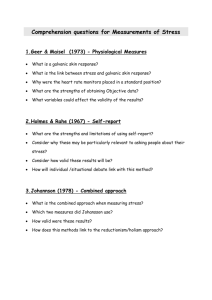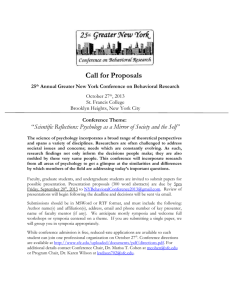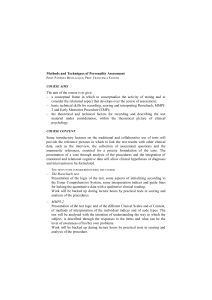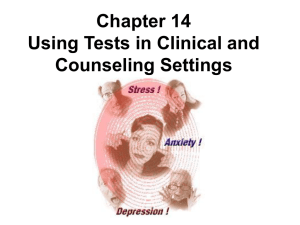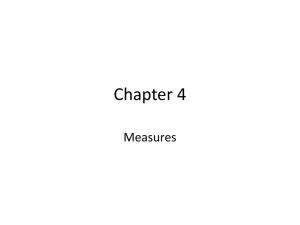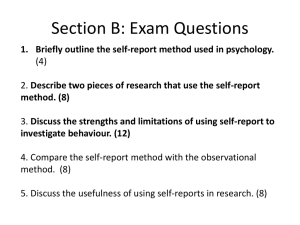160 chapter 8 outline
advertisement
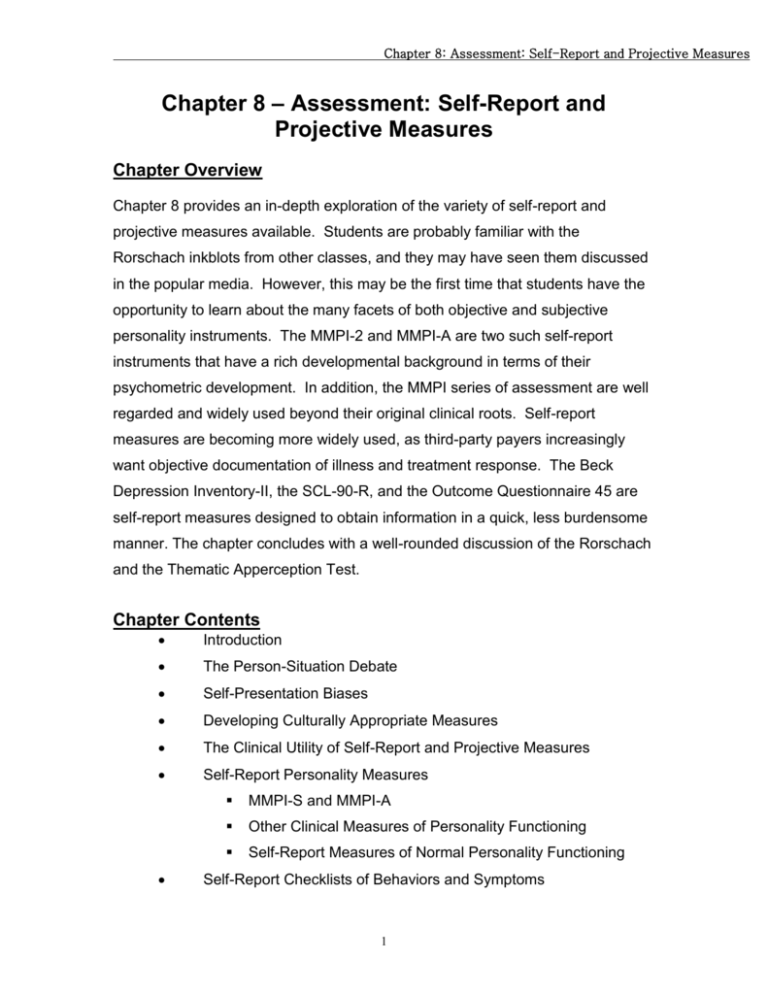
Chapter 8: Assessment: Self-Report and Projective Measures Chapter 8 – Assessment: Self-Report and Projective Measures Chapter Overview Chapter 8 provides an in-depth exploration of the variety of self-report and projective measures available. Students are probably familiar with the Rorschach inkblots from other classes, and they may have seen them discussed in the popular media. However, this may be the first time that students have the opportunity to learn about the many facets of both objective and subjective personality instruments. The MMPI-2 and MMPI-A are two such self-report instruments that have a rich developmental background in terms of their psychometric development. In addition, the MMPI series of assessment are well regarded and widely used beyond their original clinical roots. Self-report measures are becoming more widely used, as third-party payers increasingly want objective documentation of illness and treatment response. The Beck Depression Inventory-II, the SCL-90-R, and the Outcome Questionnaire 45 are self-report measures designed to obtain information in a quick, less burdensome manner. The chapter concludes with a well-rounded discussion of the Rorschach and the Thematic Apperception Test. Chapter Contents Introduction The Person-Situation Debate Self-Presentation Biases Developing Culturally Appropriate Measures The Clinical Utility of Self-Report and Projective Measures Self-Report Personality Measures MMPI-S and MMPI-A Other Clinical Measures of Personality Functioning Self-Report Measures of Normal Personality Functioning Self-Report Checklists of Behaviors and Symptoms 1 Chapter 8: Assessment: Self-Report and Projective Measures Achenbach System of Empirically Based Assessment SCL-90-R Outcome Questionnaire 45 Beck Depression Inventory-II Children’s Depression Inventory 2 Projective Measures of Personality Rorschach Inkblot Test Thematic Apperception Test Summary and Conclusions Learning Objectives 1. What is the difference between objective and projective personality tests? 2. Discuss the person-situation debate. 3. What are self-presentation biases? 4. Discuss malingering and how this affects assessment. 5. Discuss the reasons why personality measures must be relevant and unbiased across cultures. 6. How can culture affect assessment of the patient? 7. How should a clinician conduct an assessment with someone from an ethnic minority background? 8. What is the clinical utility of self-report and projective measures? 9. What are the most commonly used self-report and projective measures? 10. Discuss the background issues of the MMPI-2 and MMPI-A 11. What are the content scales of the MMPI-2? 12. Discuss the MMPI-2 validity scales and their importance to assessment? 13. What are the administration, scoring, and interpretation issues of the MMPI-2 and MMPI-A? 14. Discuss the code types of the MMPI-2. 15. Discuss the Million measures. 16. What is the Personality Assessment Inventory and how was it normed? 17. Why are self-report checklists becoming more widely used? 2 Chapter 8: Assessment: Self-Report and Projective Measures 18. What is the Achenbach system of assessment? 19. Discuss the purpose of the SCL-90-R. 20. Discuss the purpose of the Outcome Questionnaire 45 21. What is the benefit of using the Beck Depression Inventory-II and the Children’s Depression Inventory 2? 22. What the limitations of the projective personality measures? 23. Discuss the positives and negatives of the Rorschach. 24. Discuss the positives and negatives of the TAT. Up for Discussion 1. How can a clinician determine if a patient is malingering? 2. What is the difference between malingering and social desirability? 3. How is malingering different from factitious disorder? 4. Can we ever design a culturally appropriate measure? 5. Why are self-report measures more reliable than projective measures? 6. Besides clinical applications, what other uses are there for the MMPI-2? 7. How can the results of self-report measures justify continued, necessary inpatient treatment for the patient? 8. Why are self-report measures used with the normal population? 9. What are the dangers of relying on self-report measures only for diagnosis? 10. What are the limitations of the self-report measures? 11. Why do clinicians continue to use the Rorschach and TAT? 12. Discuss the specific clinical presentations that you would consider using the Rorschach and TAT. 13. Describe how John Exner’s system gives credibility to the Rorschach? 14. If you can obtain any self-report measures, have the class complete one or two and provide their feedback. 3 Chapter 8: Assessment: Self-Report and Projective Measures Out-of-Class Activities 1. Have students research the issue of malingering and the ramifications on clinical assessment. Have them write up their findings and discuss in class. 2. Students should reflect on the steps they would take to handle a patient who was malingering. Consider extreme values on the self-report tests, non-existent symptoms, etc. They should discuss their own internal feelings and how this could affect their clinical judgment. They then will present to the class or provide a write up of the questions. 3. Students should write up to ten questions on a topic that is uncomfortable such as sex, politics, religion, prejudice, etc. Have students pair up inside of class or pair up with a friend outside of class and present the questions to the person as a self-report. They then should personally administer these same questions to someone they know and someone they do not know very well. Students should note the differences in responses and the tie-in with social desirability. Have the students write up their reactions and findings. Use this exercise to stimulate more discussion in class. 4. Have students look up the following assessments and provide a critique of them: the Beck Depression Inventory-II and the Children’s Depression Inventory 2. Web Links This Web site highlights and discusses the Rorschach, the TAT, the Sentence Completion Test, and the House-Tree-Person Test. http://allpsych.com/personalitysynopsis/rorschach.html Western Psychological Services (WPS) is a leading publisher of tests, books, software, and therapy tools for professionals in psychology, education, and allied fields. http://www.wpspublish.com/ This is the Web site for Multi-Health Systems, Inc. (MHS), publishers of the Conners' Rating Scales-Revised, the Children's Depression Inventory, the Rorschach Interpretation Assistance Program: Version 5, and numerous other scales. http://www.mhs.com/ This is the Web site for Pearson Assessments. Here you will find such tests as the SCL-90-R, the Beck Depression Inventory-II, and the Children’s Depression Inventory. 4 Chapter 8: Assessment: Self-Report and Projective Measures http://www.pearsonassessments.com/ MMPI-2, on the publisher’s site: http://www.pearsonassessments.com/tests/mmpi_2.htm MMPI-A, on the publisher’s site: http://www.pearsonassessments.com/tests/mmpia.htm MCMI-II, on the publisher’s site: http://www.pearsonassessments.com/tests/mcmi_3.htm MACI, on the publisher’s site: http://www.pearsonassessments.com/tests/maci.htm PAI, on the publisher’s site: http://www4.parinc.com/Products/ProductIC.aspx?ProductID=IC-PAI ASEBA, on the publisher’s site: http://www.aseba.org/ Video Suggestions Personality Traits and Assessment (DVD, color, 30 min.) Introducing personality assessment tools, this DVD explains how psychological tests measure aspects of personality. It compares the 16-personality-factor theory with the threedimensional and five-factor models. Insight Media. Giving the Rorschach Test: Klopfer Method. (DVD, B&W, 10 min.) This program demonstrates the Klopfer method with a subject using actual Rorschach cards. Insight Media. Research with Projective Techniques (DVD, color, 38 min.) This program examines projective techniques in research, including photelecitation, thematic apperception tests, and sentence completion tests. It features interviews with psychologists; market researchers; and professors of communication, journalism, marketing, management, and sociology. Insight Media. Suggested Readings Butcher, J.N. (2009). Oxford Handbook of Personality Assessment. Oxford University Press. Groth-Marnat, G. (2003). Handbook of psychological assessment (4th ed.). Hoboken, NJ: John Wiley & Sons. 5 Chapter 8: Assessment: Self-Report and Projective Measures Hersen, M. (Ed.). (2004). The comprehensive handbook of psychological assessment (Vols. 1–4). New York: John Wiley & Sons. Rush, A.J., First, M.B., Blacker, B. (2008). Handbook of Psychiatric Measures: 2nd Edition. American Psychiatric Publishing. Sajatovic, M. & Ramirez, L.F. (2003). Rating Scales in Mental Health: 2nd Edition. LexiComp. Loewenthal, K.M. (2001). An Introduction to Psychological Tests and Scales: 2nd Edition. Psychology Press, Taylor and Francis Group. Weiner, I. B., & Greene, R. L. (2008). Handbook of personality assessment. New York: John Wiley & Sons. Wood, J. M., Nezworski, M. T., Lilienfeld, S. O., & Garb, H. N. (2003). What’s wrong with the Rorschach? Science confronts the controversial inkblot test. New York: John Wiley & Sons. 6
